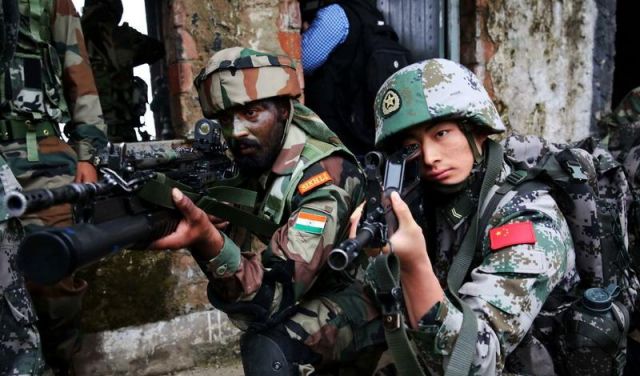
India and China begin counter-terror drills in Kunming, as well as the Malabar-2015 naval exercises in the Bay of Bengal.
India’s attempt to keep China engaged in a military-cooperation cycle while it bolters defence ties with the United States and Japan is becoming strikingly illustrated this week when it begins counter-terror drills in Kunming, as well as the Malabar-2015 naval exercises in the Bay of Bengal.
The joint Hand-in-Hand counterterrorism exercises between India and China started on Monday, following the arrival in Kunming of 175 personnel from the Naga Regiment of the Eastern Command. An equal number of Chinese personnel from the Chengdu based 14 corps are participating in the manouevres whose aim is “to develop joint operating capability, share useful experience in counter-terrorism operations and to promote friendly exchanges between the armies of India and China”. This year’s annual exercise kicked off with addresses at Kunming’s Dabanqiao Training Base by Lieutenant General Surinder Singh, Head of Observers Delegation, and Ashok K. Kantha, India’s ambassador to China, and Lieutenant General Zhou Xiaozhou from China.
While these exercises will continue till October 22, the much larger Malabar-2015 naval drills, with the U.S. and Japan will commence later this week in the Bay of Bengal.
In view of the growing tensions with Japan, the Chinese are focusing their attention on the format of this exercise to gauge whether the joint Indo-US exercises are morphing into a trilateral framework with Tokyo as a permanent participant. If that happens, it will re-open the question whether Indian foreign policy is now shifting gears towards an active support for the U.S. led “Asia- Pivot”. The Chinese perceive President Barack Obama’s “Asia Pivot” or “rebalance” doctrine as a thinly veiled attempt aimed at China’s containment. Japan, South Korea and Australia are firm allies in this enterprise, but New Delhi has so far carefully avoided in bracketing itself with the coalition, notwithstanding the adoption of higher amplitude in expressing its concerns in the South China Sea.
Analysts say that China’s sharper focus on the Malabar-2015 can be attributed to the first meeting of the foreign ministers of India, U.S., and Japan in New York last month where the exercise was discussed, according to a media note circulated by the U.S. State department. The statement also noted the “growing convergence” of the three countries in the Indo-Pacific region, referring to the sea-space on either side of the strategic Malacca straits, which is the life-line of East-West trade.
Regarding the Kunming exercise, a write-up in the Global Times, a state-run tabloid, pointed out at that China and India “have agreed to enhance their military cooperation, and to boost people-to-people exchanges”. It noted that New Delhi has also proposed joint forays in counter terrorism, along with combating smuggling by sea and anti-piracy operations.
The article signaled India and China’s shared interest in what has been described as an emerging new world order centered around the Brazil-Russia-India-China-South Africa (BRICS) grouping.
“A grander mission is that as representatives of emerging economies and members of the BRICS countries, both Beijing and New Delhi should boost their cooperation while improving themselves, in order to jointly create an Asian century, make breakthroughs in the current financial order, and forge a new global economic order that is more in line with emerging markets’ interests,” the daily observed.